Do you ever get stuck or bored with the same miniature painting approach? I do. After a while, I feel restricted to a miniature painting formula. I’m afraid that if I change my approach, the results of my miniature paintings will suffer. To free myself from the fear of painting miniatures, I force myself to “loosen up”. I take my tried and true formula for consistent miniature painting and throw it out the window. Of course, this doesn’t mean I trash my work. Rather, I try to inject a more spontaneous and expressive painting style into to my miniatures.
In this article, I share with you why and how to apply 10 creative ways to paint miniatures with a more expressive or painterly style. An expressive or painterly style takes the “normal workflow” for painting miniatures, e.g., clean lines, smooth blends, and loosens it up. I’ve discovered that this not only helps break you out of a rut, increasing motivation, but also adds a bit of your personality and character into your model painting.
What is Expressive or Painterly Miniature Painting?
Expressive painting is a style of art that shows off the artist’s medium. In this case, an expressive painting reveals the character of paint and the brush. Although some expressive paintings appear unfinished or messy, they are the result of an artist who is expressing their personal core, their emotions and state of mind.

Unlike smooth blended colors, or photo-realistic pieces of work, expressive painterly art ignores conventional formulae and propriety. An expressive painting is whatever it is. A “you be you”, kind of painting.
For the miniature painter, an expressive style may emerge from the use of oil, watercolor, or acrylic paints. The final painted miniatures may appear with clear brushstrokes, unblended swatches of color, and characterful texture from paint and other mediums.
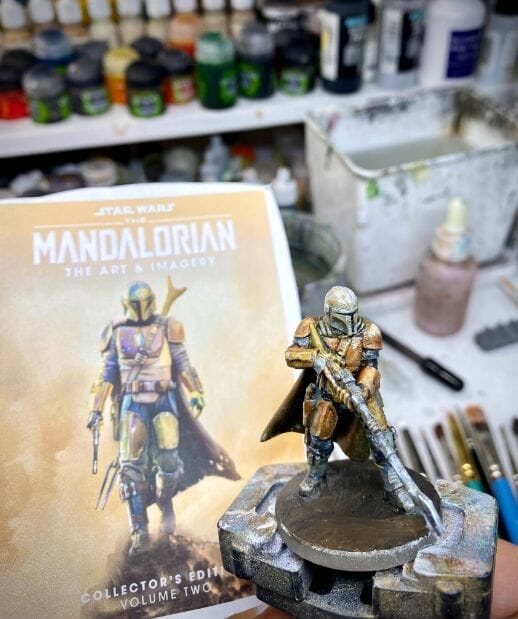
READ MORE: 10 GREAT OIL PAINTS FOR MINIATURES
Although some people may consider expressive or painterly styles of miniature painting unfinished or messy, the final outcome is not supposed to be “perfect”. Expressive miniature painting is a process that produces a style that celebrates a result that only a human could produce. No mindless automaton can produce an expressive work.
In fact, you can’t replicate the painterly style of another artist. Your miniature painted with an expressive style will be yours alone.
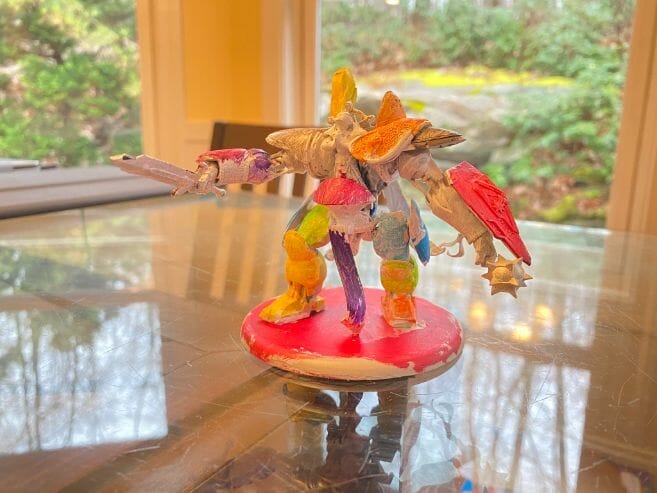
The Tools of an Expressive Miniature Painter
The painterly approach of painting miniatures still requires you to understand and know the basics of painting. You must understand how to mix colors, the key to good composition, and the vitality of contrast. You need to know the rules to break them.
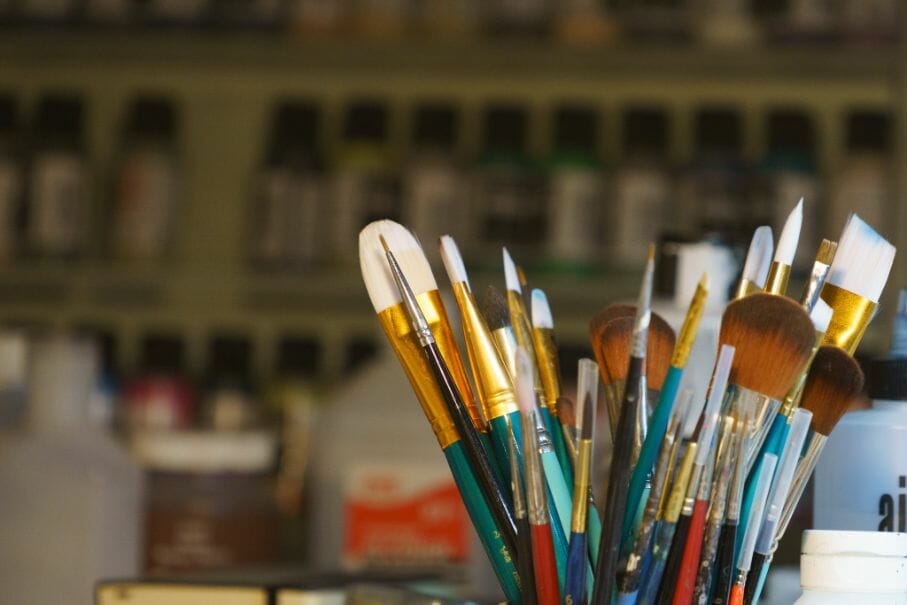
To be an effective painter with an expressive style, you will need to know how to control the basic principles of your chosen art medium. In this case, as a miniature painter, this means basic approaches working with acrylic paint on 3D modeled sculpts, e.g., plastic, metal, or resin. Once you have control over the core skills, the way you create and express your style are up to you!
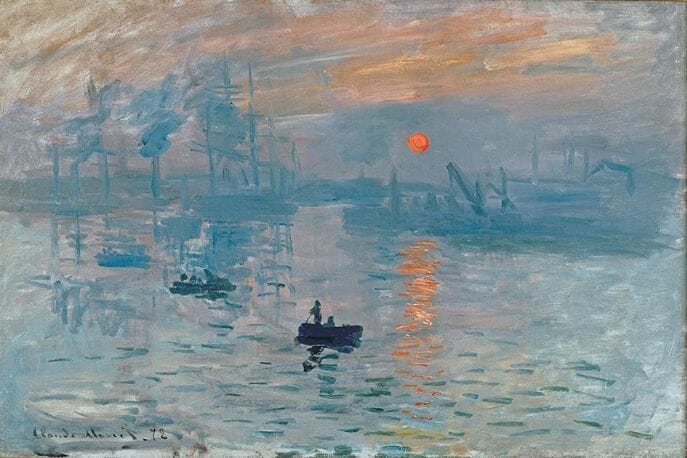
In the late-1800’s, traditional painters (Claude Monet, Vincent Van Gogh, Henri Matisse and others) understood how to make color and patterns work in their favor. They used their chosen mediums (i.e., oil, canvas, etc) to celebrate an individualistic style. Maurice Denis, a French painter, stated in 1890 that: “a picture, before being a battle horse, a nude, an anecdote or whatnot, is essentially a flat surface covered with colors assembled in a certain order.” (source).

The legacy of these painters of yesteryear are the tangible reminders of a philosophy that we can paint with individualism and originality. As a miniature painter, we only have to please ourselves. The tools of an expressive miniature painter are a brush, paint, and curiosity.
Why You Should Consider an Expressive Miniature Painting Style
If your goal is move away from a rote painting formula, then stop fighting the urge to paint to go in your way. Ignore how you’re “supposed to do things”, and go with what comes naturally to you instead. Of course, this raises the question of “how do you know what comes natural for you?” Well, it takes tons and tons of practice, spiked often with discomfort.
In the days before electricity, e.g., no social media, every artist worked in a sort of vacuum. Sure, there were art schools and pervasive schools of thought, and everyone received input from others, but information arrived slowly. Limitations in resources, e.g., types and kinds of paints, forced artists to use varied technical applications. Ultimately, the most innovative artists rose to the top of heap. They stood out, because they invented.
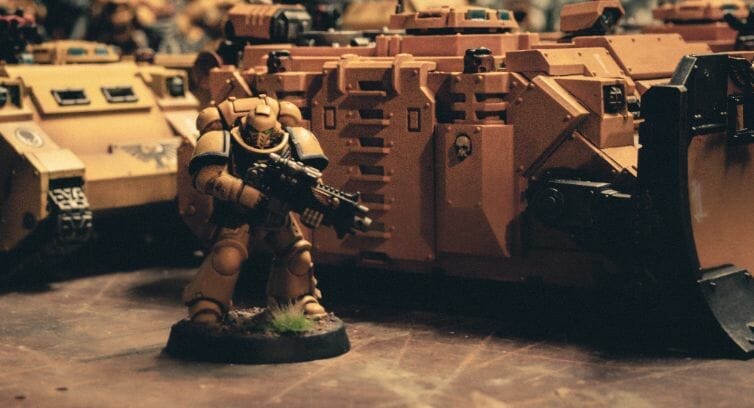
RELATED: HOW TO FIND YOUR MINIATURE PAINTING STYLE
Some painters scoured the world to create photorealistic paintings, while others left those approaches behind. Instead, artists like Van Gogh or Matisse chose to use highly saturated colors, unrealistic perspective, and novel compositions in unconventional contexts. And, all of their efforts brought them renown because they chose to work in a style that was personal.

For you and I, painting miniatures can often become boring or uninspired. This is because we tend to see something we admire on social media and try to replicate the “look”. We seek out tutorial videos, only to find that we don’t have the right brushes, paints, or hand-eye coordination to pull off the miniature style we think will make our stuff look good.
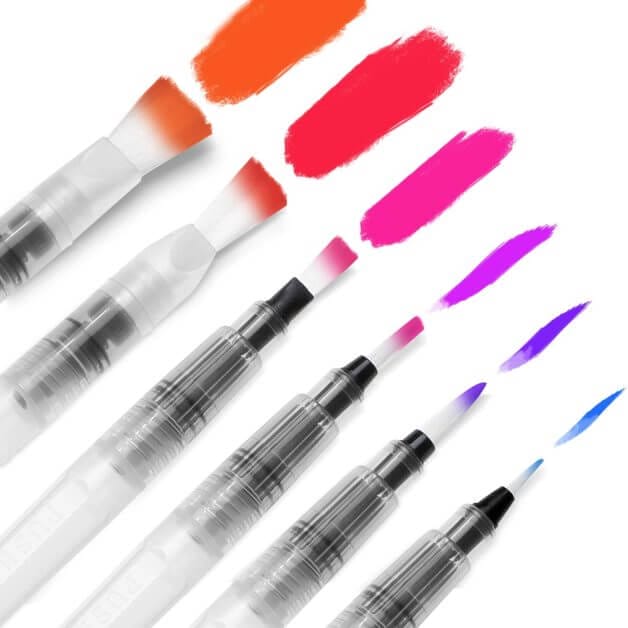
I’ve watched countless videos about the best way to wet-blend or glaze, just so I could create a convincing non-metallic metal sword. And, I only got to a point where I was satisfied through lots of practice. I still have a long way to go! But, I’m content because I have a first-hand grasp of what I enjoy and don’t like about these technique. This process was my way of finding my expressive way of painting miniatures.
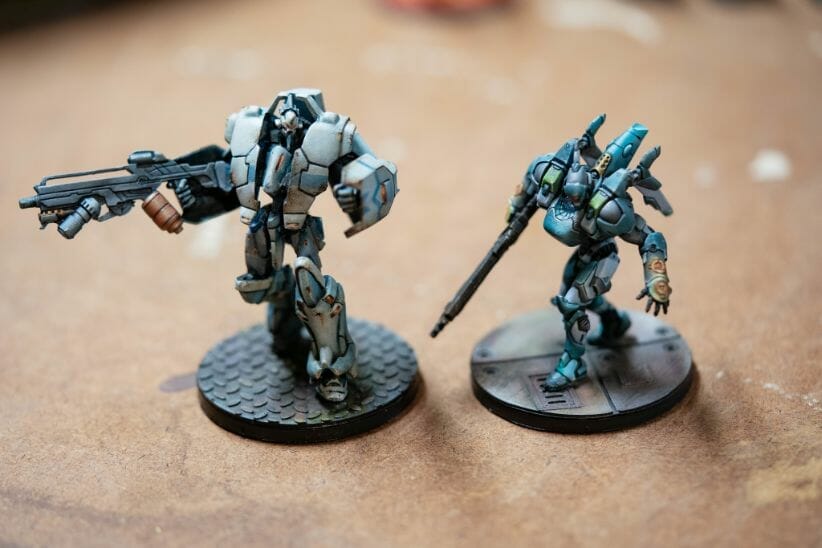
For example, nowadays, I know I prefer a grittier, more realistic appearance in my models. As a result of trying all these different painting techniques, I can ignore the painting methods that don’t help me achieve the outcome I want. In other words, I’ve developed a personal workflow to get the “look” I prefer for my miniatures.
READ MORE: 8 MUST-KNOW COLOR BLENDING TECHNIQUES FOR MINIATURE PAINTERS
For you, developing your expressive style frees you from the struggle to paint miniatures with rigid, overly-controlled techniques and formula. Loosen up. You be you. Don’t feel like you need to paint like the “pros”. Once you find your way, I bet you’ll be more confident and satisfied with your miniature painting.
How to Paint Miniatures with an Expressive Style
These are things I’ve learned from different artists over the years, e.g., back in school, hanging out with other creatives. Don’t focus on a single skill, brush technique, or linear workflow. Instead, introduce new techniques that move you away from tight, controlled art.
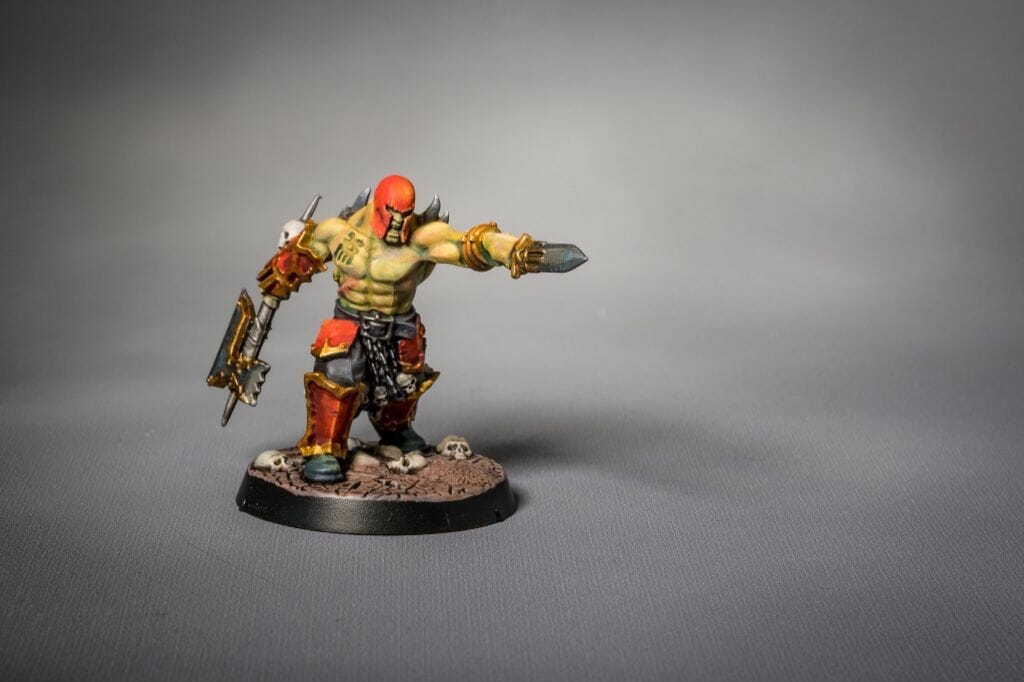
Try more than one technique over and over. Repeat things that don’t seem to work. Break out of the “this looks really bad” or “this is a dumb way to do this” mindset. Find a process of working with your paints, brushes, and other media that feel good to you. Forget what works for other miniature painters. Discover your way of painting through experimentation and discovery.
For more ideas for practicing ways to develop an expressive style in miniature painting, check out the 10 exercises below.
10 Creative Ways to Develop an Expressive Style in Miniature Painting
1. Use a Bigger Brush
When you paint with a larger paint brush you’re forced to loosen up. You’ll lose an element of control with a larger brush. But, that’s okay! Expressive miniature painting is about the expressing your unique feelings into the work. With a larger paint brush, that restrictive idea that you need to control everything goes out the door.
Take a larger brush that you feel comfortable using, then take it up a notch so you’re right outside your comfort zone. Apply paint. The result you’ll discover is larger brush strokes, swatches of color going to places you might not expect, and textures and painting character that fall outside your normal way of doing things. Play around with how paint behaves with your tool, rather than forcing it all of these things to do your bidding.
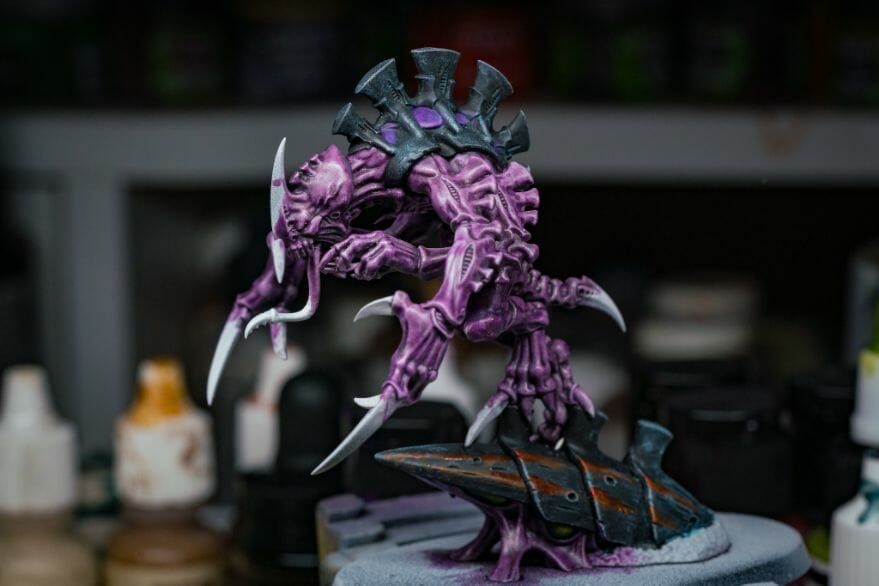
Alternatively, instead of using a bigger brush, use the brush you normally do. Except this time, hold the brush high up the handle, farthest away from the bristles. Rather than holding your paint brush near the ferrule, grip from the end. This will loosen up your brush strokes into wider sweeping movements. Don’t fight back and compensate with smaller movements. Let the bristles and paint do their work for you.
Ultimately, putting this into practice either with a bigger brush or a looser grip on your current brush, will create the freedom of movement you need for allowing yourself to express color and form in a new way.
2. Use Oil Paints Instead of Acrylic
For miniature painters, acrylic paints are popular because they dry quickly, don’t require harsh solvents, and are durable. On the other hand, acrylic paints have significant limitations. They dry quickly, which makes color blending less intuitive. To blend color, you have to apply more sophisticated techniques, such as wet-blending or layering and glazing.
Oil paints on the other hand are a sensuous medium and act very differently than conventional acrylic hobby paints. Oil paints allow you to use a more intuitive approach for applying color to a miniature. You can see examples of how I use oil paints on miniatures here and here.

Here’s what I mean. With acrylic miniature painting, when you want to add color, you need to work in a linear fashion. You have to plan ahead a bit to make sure your layers work together to create the final result. For example, after you add the base coat the surface, you apply the next layer. And, you repeat this until you add your highlights and shadows. This all comes together at the end for your final miniature painting.
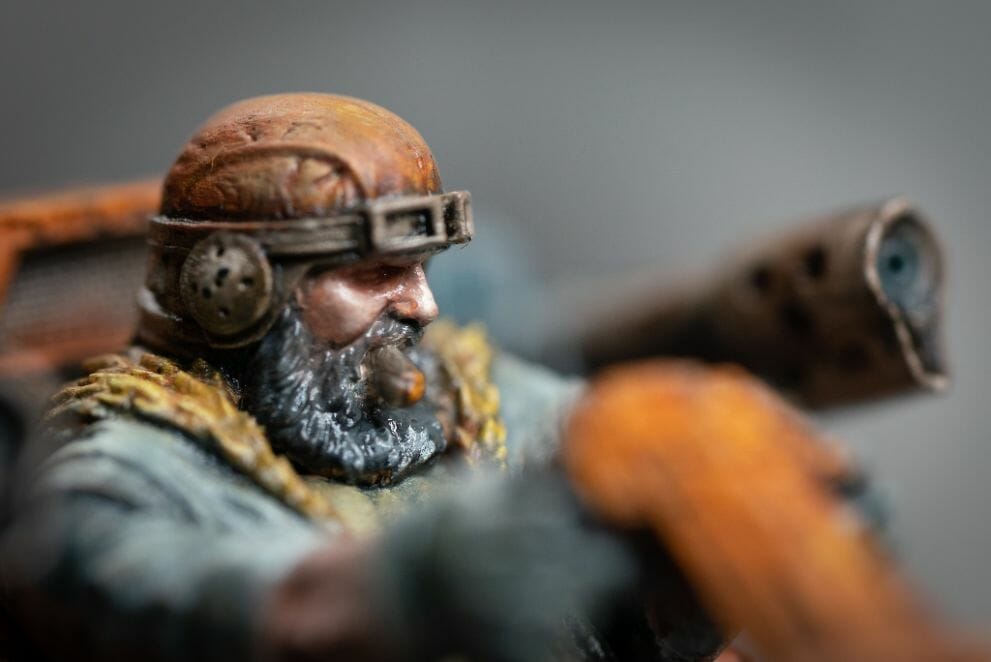
On the other hand, with oil paints, you can add colors in any order you like. There is no layering. For example, if you want to apply blue to a miniature’s surface, you first apply the oil color. If you decide it needs shade or highlight, you’re in no rush. You can wait a few hours or even a day before blending in another oil paint. You can even “erase” some of your work because the paint stays malleable for a long time.
RELATED: BASIC TIPS FOR PAINTING MINIATURES WITH OIL PAINTS
Because oil paint doesn’t dry right away, all you need to do is add another paint color on top. Instead of covering the underlying paint, like would happen with acrylic, an overlying layer of oil paint will naturally mix with previous paint. This process allows you to add, modify, and adjust paint applications “on-the-fly”. You don’t have to plan so much. Rather, you go with the flow.
You can rely on your intuition and instinct to paint miniatures. How liberating is that!
I would note that when starting out with oil paints, don’t try to blend and smooth everything out. Expressive painting should celebrate the character of mediums you’re using. Embrace your brushstrokes and colors, and the way your brush creates textures. If you overly smooth your paint on the model, it’ll end up looking flat and lifeless.
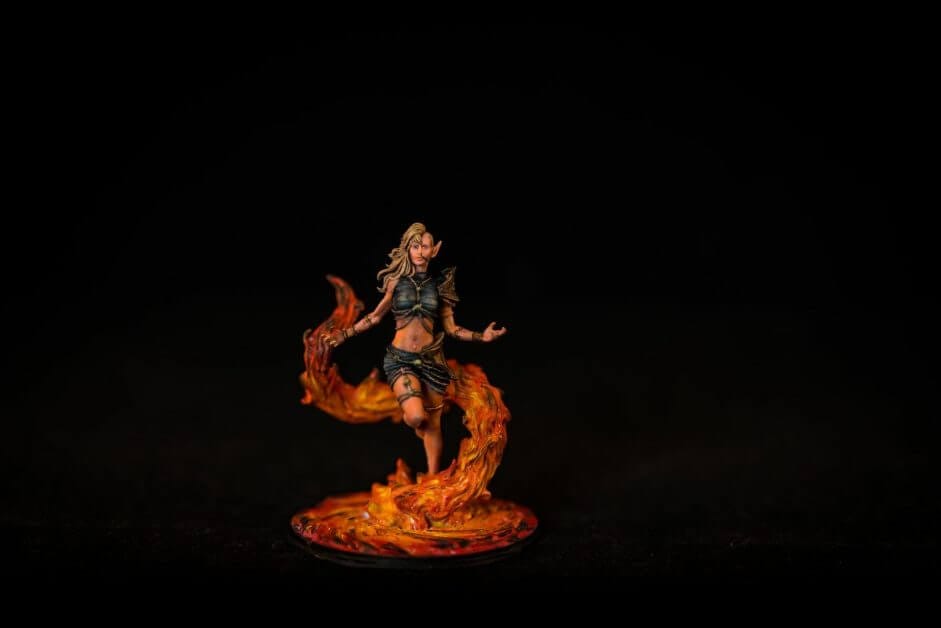
Resisting the urge to blend and smooth your paint is hard. At some point, you’ll have to tell yourself to stop working on your painting and decide that your expressive miniature painting style is done. It’s time to move to the next painting. In other words, try not to overly tweak your miniature painting. Perfection isn’t your purpose.
3. Paint with Poor Light
A great way to learn how to paint miniature with a more expressive style is to use sub-optimal light. Using a dim lamp or one that emits light with an “off” color-temperature will make two things happen to how your miniatures appear. First, a dimmer lamp will reduce surface contrast. Second, a light color temperature that is too warm (e.g., incandescent bulb) or cool will distort paint color.
RELATED: BEST LAMPS AND LIGHTS FOR PAINTING MINIATURES
Here’s how these two sub-optimal lighting conditions will affect how you paint miniatures in a good way. For more expressive miniature painting, learning how to act independently from tried and true conventions, will push you toward unique ways of doing things.
Under a dim lighting condition, you’ll lose the ability to see contrast well on your models. Light and shadow will blur out. In this case, you’ll be in a position to loosen up how you’re supposed to paint. To maintain contrast, you’ll want to dip into darker and brighter paints. Ultimately, you’ll discover that the dynamic range on your miniature depends on your ambient lighting.
Similarly, when you paint with a light source that isn’t emitting an “ideal” color temperature, you’ll have to surrender your preconceived notion of how colors should appear. Your color theory, and the way you think colors should harmonize will fall away. In its place, you’ll come to a weird place of understanding that light and shadow play a much more important role in how well you can paint miniatures.
A painterly style moves you away from convention and formulae. Removing good light teaches you how to rely on your intuition and instinct.
4. Ignore Details
Expressing yourself is more often about the big picture. In miniature painting, the details have less impact on the over appearance of the model. To free yourself from stiff painting techniques, highly-controlled brush strokes, think less about the details and more about the bigger shapes and forms on the model.
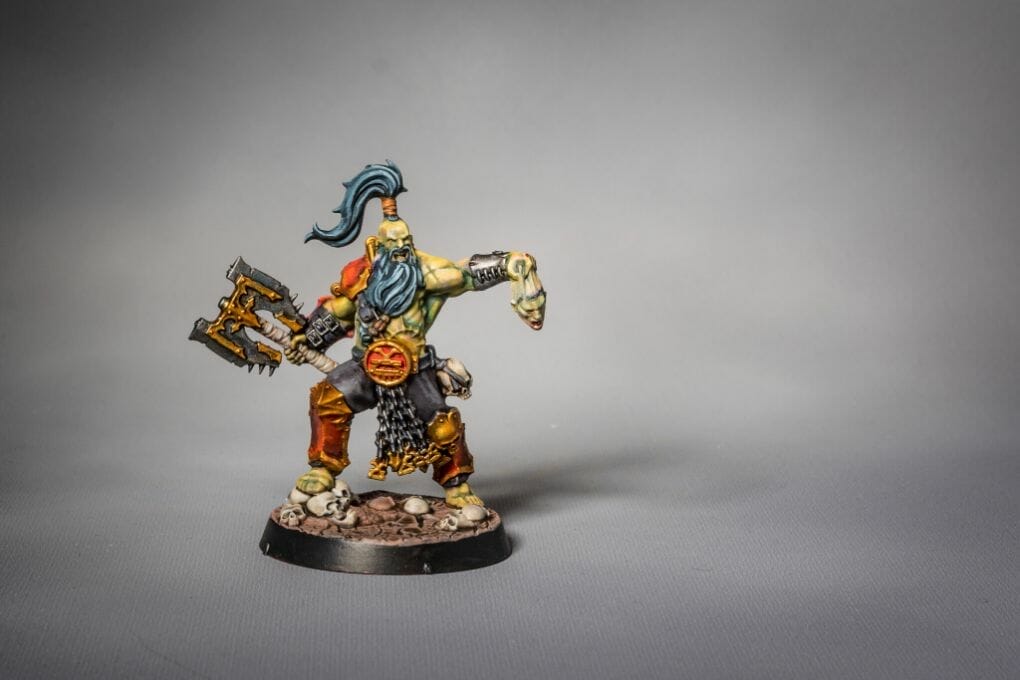
When you paint miniatures, the itty-bitty details slow you down a lot. I find that most of the time you can ignore painting these finer details on a model and still get away with a great miniature paint job. As with the other ways for painting miniatures with a more expressive style, overlooking the details can help you relax and work the way that feels more natural to you.
5. Paint with Your Other Hand
After painting miniature for a while, you build a “muscle memory” into the way you do things. This mean if you’re left- or right-hand dominant, you’re already using instinct and habit to paint. There is a strong link between your hand and mind. To gain an appreciation for the painterly, expressive approach for miniature painting, switch your brush to your non-dominant hand.
Sure, this is going to seem weird. You’ll have less coordination and control. But, this is a good thing! Although paint won’t go where it’s supposed to at first, you’ll find yourself becoming more expressive with practice. You’ll lose the rigid control that makes your brushstrokes stiff and rote.
Resist the urge to clean up your missed marks. Instead, the key is to persist through the awkwardness until you grow accustomed to using the “wrong” hand. Slowly, you’ll find yourself being able to control the paint and put color where you want it.
Use the opposite hand enough and eventually you may discover that you paint with both hands together! This would make your miniature painting more expressive and could even become useful for speeding up your miniature painting workflow.
6. Allow Paint Drips
Wait, what? With all miniature painting, an good guideline to follow is to “thin your paints”. Thinner paints allows you to preserve the details on the model’s surface, while allowing you to paint smoother and avoid the look of paint brushstrokes.
Take it a step further and allow your thinned paints to drip a bit. Slop on the paint and allow “happy accidents” to happen. Don’t clean up the drips. Let the color seep into new, unexpected places. Learn to leverage the paint drips and splashes. Let the paint’s behavior guide your approach. Remember, that an expressive painting style should celebrate the artist’s medium.
You will find that with an open mind that certain fantastic things will occur with paint that you may not have known if you wrestled the color too much. For example, Neil Amswych, a color blind comic style painter, allows his black ink to drip in different areas of the miniature. The ink seeps into unexpected places. And, in many cases the dripping black ink creates an awesome effect! Neil doesn’t fight the drip.
Use the fluidity of paint to mark up your miniature. Allow the drips to dry and cover them with a translucent layer of paint. Let the drips add character and texture to your model.
7. Use Masks
You can use inexpensive sticky tack or masking fluid (e.g., liquid frisket) to mask specific areas of a miniature. This allows you to use an expressive style on parts of a model and preserve other areas for more limited, strict painting techniques. For example, you could mask the armored plates of a model, while you paint the flesh and cloth with a painterly approach.

Then, you can remove the mask and use more conventional painting techniques to paint the armor, such as using an NMM style or metallic paints. Combining an expressive, organic painting style with a highly-controlled painting technique is a fantastic way to bring a unique look to a miniature painting. This hybrid approach is a great compromise for those of you who don’t feel comfortable committing to a complete painterly approach for the whole miniature.
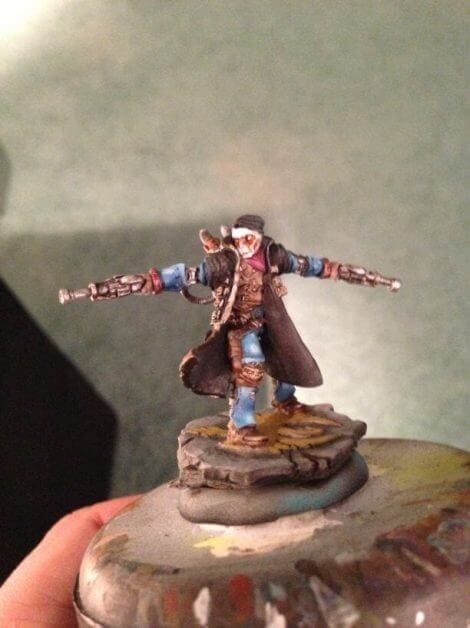
Masking is also useful for airbrushing miniatures. With an airbrush, you can cover large areas of model in color. You can take normal acrylic paint and thinly layer it over other colors for smooth paint blends that would be difficult otherwise with a regular brush. Using stencils that you buy or make yourself is a great way to use an airbrush to add texture and character to your miniature painting.
I will note that over-use of an airbrush, e.g., using it to smoothly blend everything, will end up creating a flat and boring aesthetic to your model. Many commissioned painters use an airbrush a lot because it is fast and produces a reliable contrasty look. However, an airbrush tends to create a look that is very same-y after a while, and precludes the individualism that an artist would want to bring to a miniature paint job.
Ultimately, you’ll get bored with using an airbrush by itself. Importantly, airbrushing alone will fail to produce a model with unique character. You’ll always want to use a regular paint brush to finish painting a miniature.
8. Let the Paint Flow
To liberate yourself from restrictive methods of painting miniatures, try using the wet-in-wet approach over the entire model. Working on large sections at a time, first paint your model with clean water. Then, brush paint right into the wetter surface. The paint pigment will diffuse through the water on the model’s surface. You’ll have little control over the flow paint. Color will spread in every which direction.
After each color dries, apply clean water to another part of the miniature and repeat the process with paint. In the beginning, the model will looks messy and sloppy. But, if you recognize what we’re doing, we’re borrowing a tried-and-true method that watercolorists use. Wetting the surface with clear water forms a layer through which fluid paint can diffuse and spread across the surface.
The benefit of using the wet-in-wet blending approach is the lack of control. Expression is organic and should emerge naturally through the medium you’re using. In this case, the mixture of water and paint pigments on miniature’s surface.
You can gain some control over how the paint behaves by thinning (or not thinning) the paint before applying it to the wet surface on the model. Be patient with this technique. Study how paint flows across the sculpted surface when it is wet. Understand what happens to paint color when it encounters the interface between the wet and dry surfaces of a model. Notice how the pigment deposits when it is dry.
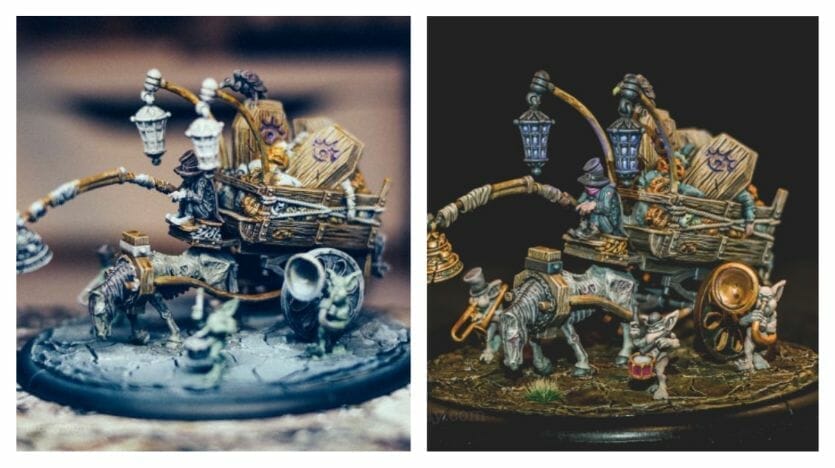
All of these observations will help you develop a more expressive, organic way of working and thinking about your miniature painting. Remember to allow yourself the freedom to finish the entire miniature painting first before judging the results. As with traditional painting, your miniature painting will usually appear messy and ugly until it is complete. Allow your work to find its natural endpoint before deciding whether you like it or not.
Just as your personality flows from you when you interact with the World, so too should paint flow when it interacts with its final resting place.
9. Paint in Reverse
If you’ve been painting miniatures for a while, whether they are tabletop wargaming models and terrain, or scale model trains, there is a formula you seem to follow for applying paint color. For example, when you start painting a model, you’ll first base coat with a midtone color. Then, you’ll shade this base color, perhaps with a darkening wash. As a highlight, you’ll layer up to a brighter color.
Your general workflow may appear something like this: Paint the midtone, then shadow, and finish with a highlight.
Do you know how the workflow you always use came to exist? Someone did it before you, and somehow passed it along. Did we merely accept their way of doing things as fact through faith? Perhaps you discovered a way of painting miniatures and validated the approach through others. In either case, this is a sort of fenced-in way of working. Let’s see if you can push outward from this envelope.
To break free from the limitations of your tried formula, go in reverse. Take your workflow and flip it backwards. From the example above, start with a bright color instead, and paint toward the mid tone. Mix and match your paint applications, so layers you would have done earlier, you do last. Play with your color layering sequence until you find a method that seems to fit your instinct for painting.
If you’re someone who always applies black primer, try a white primer. See how your paint color choices and techniques must adjust to the new starting environment. A method for finding your expressive style is breaking your old way of thinking and doing, and replacing the gap with your creativity and ingenuity.
Don’t even try to think. Start with any color at random, and make it work.
10. Paint in Black and White
As miniature painters, we’re often over-obsessed with color. Choosing the right colors to work together, e.g., color harmony, takes up a lot of mental energy. Consider the huge library of books for sale about color theory. It’s ridiculous. People get doctorates in color psychology.
Here’s a secret every artists knows: Contrast does all the work, but color takes all the credit.
Allow yourself to remove color from the miniature painting equation. Try painting miniatures in black and white paint, only. Of course, you’ll have to learn how to properly mix black and white to form the intermediary midtones for your model. But, you’ll learn the important lesson of how to see and paint your miniatures with shadow and light.
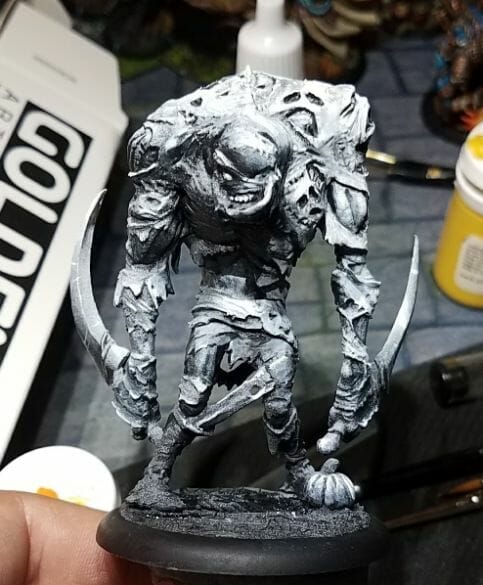
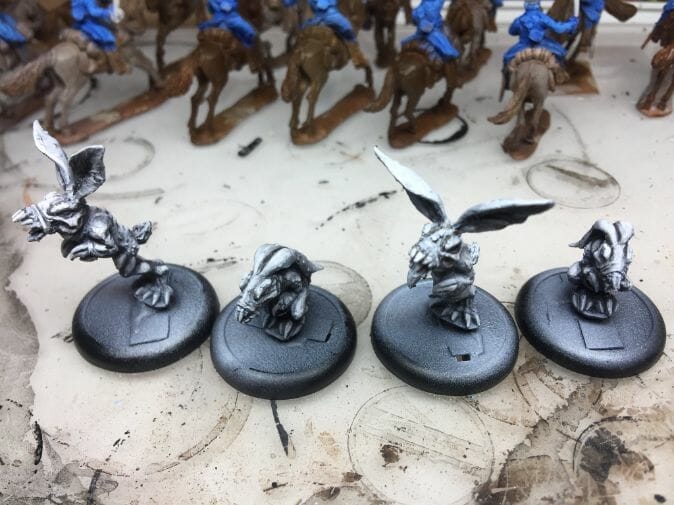
Street photographers often turn their camera’s color palette off, so they can only view their subjects in black and white. By only allowing black and white visual information, a photographer is forced to concentrate on the shapes, forms, and juxtaposed elements that create their subject. There are no distractions from colors or the businesses of correcting white balance. There is only contrast.
I enjoy black and white photography for the purity of the medium. I’ve tried it myself and you can see an example in this post. Learning how to capture effective images in black and white gave me the tools to understand why I enjoy certain visuals compositions.
RELATED: HOW TO ZENITHAL HIGHLIGHT MINIATURES
I’m less reliant on color to express how I see and think about visual aesthetics. So much so, that I think applying a black and white application to miniatures is one of the most powerful tools you can use to paint better miniatures, painterly styling or not. In fact, you can use black and white photography to help improve your miniature paintings.
At the end of a black and white painted miniatures, if you feel it would help, you can always add color back through transparent inks and glazes. Some commercially available acrylics are also available to quickly add color to a black and white painted miniature. You can try products like Citadel Contrast Color or Scale 75 Instant Color.
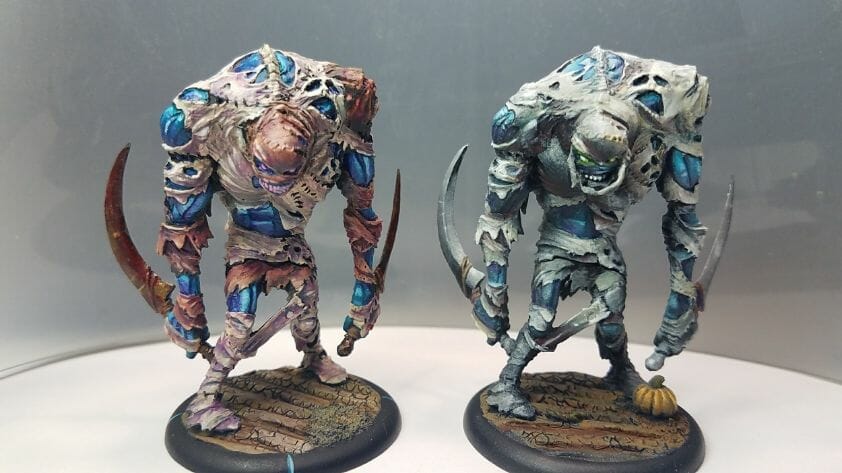
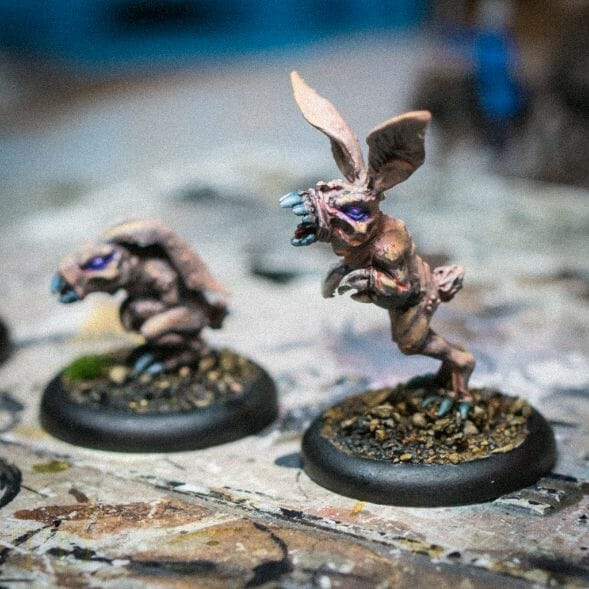
When painting miniatures with black and white paint, remember to restrict your use of pure black or white. The extremes should be reserved for those super-limited areas of your model that are in total darkness or absolute light. Unless, of course, it is your intention to paint with forms that differ from reality. It is your miniature painting afterall. 😇
Bonus: Paint Different Miniatures and Models (Genre, Theme, Scales)
A great way to break out of your comfort zone and find new ways to express your creativity, is to paint models that you wouldn’t otherwise consider. For example, if you’re always painting Warhammer 40k models, try painting Age of Sigmar, or better yet, try painting a bust or a 75mm scale resin figure.
Here are a some unique miniatures that I’d love to try painting:
Final Thoughts
Individualism is a principle of being independent, self-reliant, and free to act apart from the collective of thoughts of a group. In miniature painting, an expressive style projects your individualism through painting.
Developing a more expressive style gives you the tools to break free from the commonplace and the conventional. You’re able to work with less fear of making “mistakes” because you’ve internalized how to paint for you, not anyone else.
In other words, the more comfortable you are with painting miniatures with expression, a personal touch as it were, rather than with rote formulae, the less fear you will painting with the expectation of a “good paint job”. You won’t care what others (or your inner critic) thinks because you’ve embraced your style, your way. Painting miniatures your way is likely going to be relaxing, inspiring, and satisfying.
Do you have other ideas about how to expand your normal miniature painting approach? Have you tried new ways to paint miniatures with an expressive style? If so, I’d love to know what you tried and how it turned out. Leave a comment below!
Happy Miniature Painting!



Tangible Day on YouTube (Miniatures and More!)

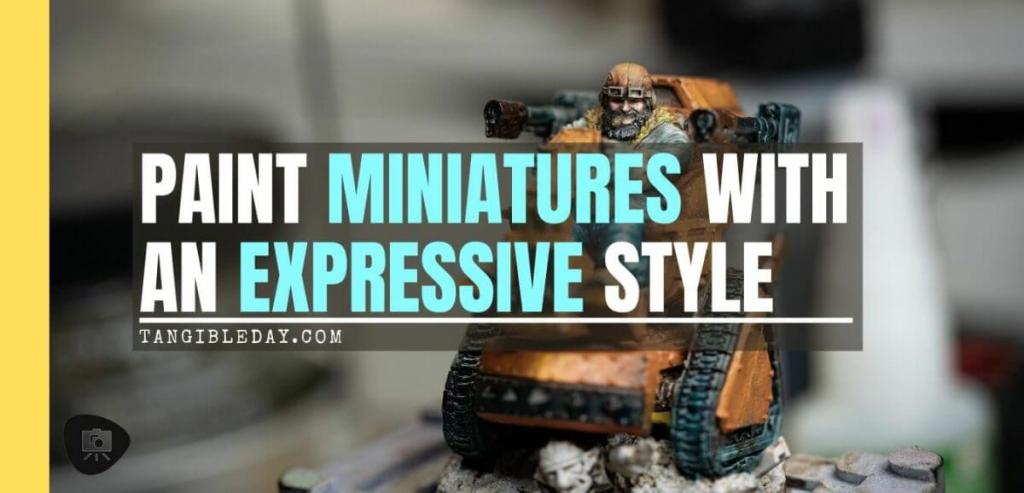
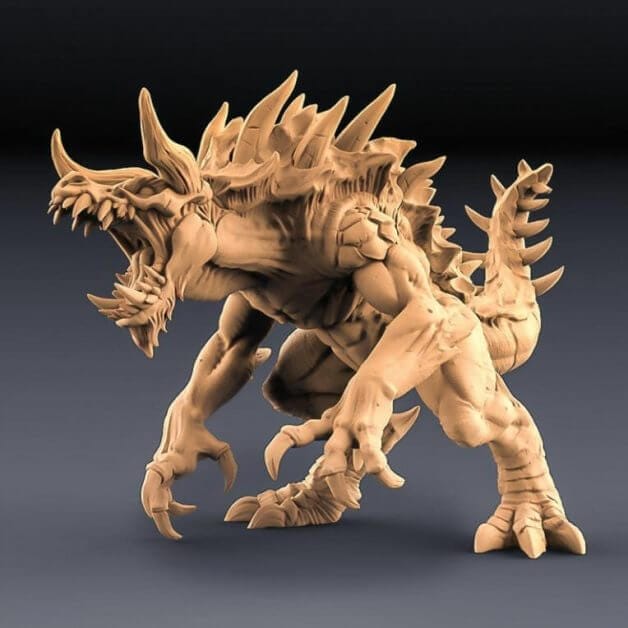
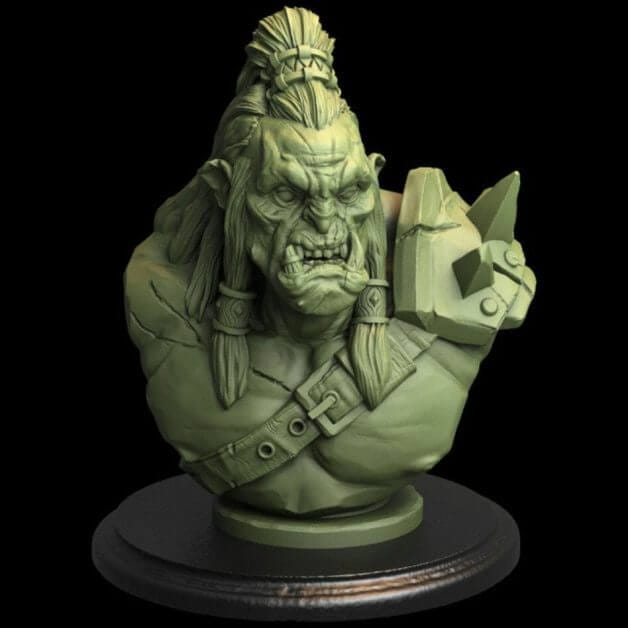
Pingback: Finding The Way Through the Maze: Keeping Momentum in Miniature Painting Projects - Tangible Day